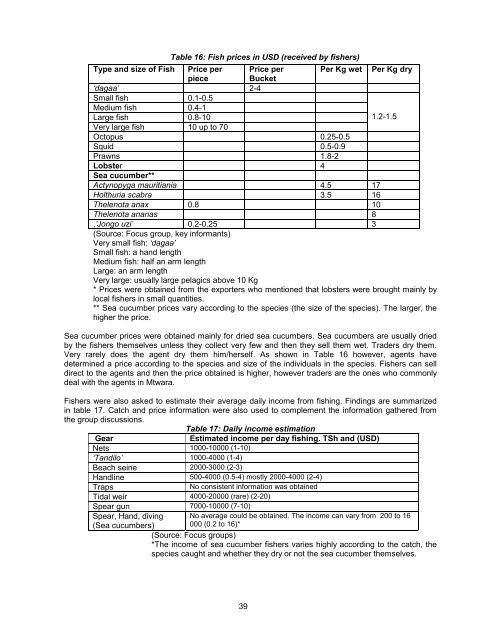a socio-economic baseline assessment of the mnazi bay - IUCN
a socio-economic baseline assessment of the mnazi bay - IUCN
a socio-economic baseline assessment of the mnazi bay - IUCN
You also want an ePaper? Increase the reach of your titles
YUMPU automatically turns print PDFs into web optimized ePapers that Google loves.
Table 16: Fish prices in USD (received by fishers)<br />
Type and size <strong>of</strong> Fish Price per Price per Per Kg wet Per Kg dry<br />
piece<br />
Bucket<br />
‘dagaa’ 2-4<br />
Small fish 0.1-0.5<br />
Medium fish 0.4-1<br />
Large fish 0.8-10<br />
1.2-1.5<br />
Very large fish 10 up to 70<br />
Octopus 0.25-0.5<br />
Squid 0.5-0.9<br />
Prawns 1.8-2<br />
Lobster 4<br />
Sea cucumber**<br />
Actynopyga mauritiania 4.5 17<br />
Holthuria scabra 3.5 16<br />
Thelenota anax 0.8 10<br />
Thelenota ananas 8<br />
,’Jongo uzi’ 0.2-0.25 3<br />
(Source: Focus group, key informants)<br />
Very small fish: ‘dagaa’<br />
Small fish: a hand length<br />
Medium fish: half an arm length<br />
Large: an arm length<br />
Very large: usually large pelagics above 10 Kg<br />
* Prices were obtained from <strong>the</strong> exporters who mentioned that lobsters were brought mainly by<br />
local fishers in small quantities.<br />
** Sea cucumber prices vary according to <strong>the</strong> species (<strong>the</strong> size <strong>of</strong> <strong>the</strong> species). The larger, <strong>the</strong><br />
higher <strong>the</strong> price.<br />
Sea cucumber prices were obtained mainly for dried sea cucumbers. Sea cucumbers are usually dried<br />
by <strong>the</strong> fishers <strong>the</strong>mselves unless <strong>the</strong>y collect very few and <strong>the</strong>n <strong>the</strong>y sell <strong>the</strong>m wet. Traders dry <strong>the</strong>m.<br />
Very rarely does <strong>the</strong> agent dry <strong>the</strong>m him/herself. As shown in Table 16 however, agents have<br />
determined a price according to <strong>the</strong> species and size <strong>of</strong> <strong>the</strong> individuals in <strong>the</strong> species. Fishers can sell<br />
direct to <strong>the</strong> agents and <strong>the</strong>n <strong>the</strong> price obtained is higher, however traders are <strong>the</strong> ones who commonly<br />
deal with <strong>the</strong> agents in Mtwara.<br />
Fishers were also asked to estimate <strong>the</strong>ir average daily income from fishing. Findings are summarized<br />
in table 17. Catch and price information were also used to complement <strong>the</strong> information ga<strong>the</strong>red from<br />
<strong>the</strong> group discussions.<br />
Table 17: Daily income estimation<br />
Gear<br />
Estimated income per day fishing. TSh and (USD)<br />
Nets 1000-10000 (1-10)<br />
‘Tandilo’ 1000-4000 (1-4)<br />
Beach seine 2000-3000 (2-3)<br />
Handline 500-4000 (0.5-4) mostly 2000-4000 (2-4)<br />
Traps<br />
No consistent information was obtained<br />
Tidal weir 4000-20000 (rare) (2-20)<br />
Spear gun 7000-10000 (7-10)<br />
Spear, Hand, diving No average could be obtained. The income can vary from 200 to 16<br />
(Sea cucumbers) 000 (0.2 to 16)*<br />
(Source: Focus groups)<br />
*The income <strong>of</strong> sea cucumber fishers varies highly according to <strong>the</strong> catch, <strong>the</strong><br />
species caught and whe<strong>the</strong>r <strong>the</strong>y dry or not <strong>the</strong> sea cucumber <strong>the</strong>mselves.<br />
39
















